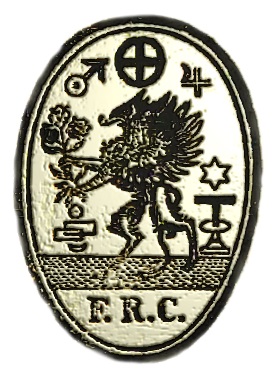Ordo Templi Orientis
| 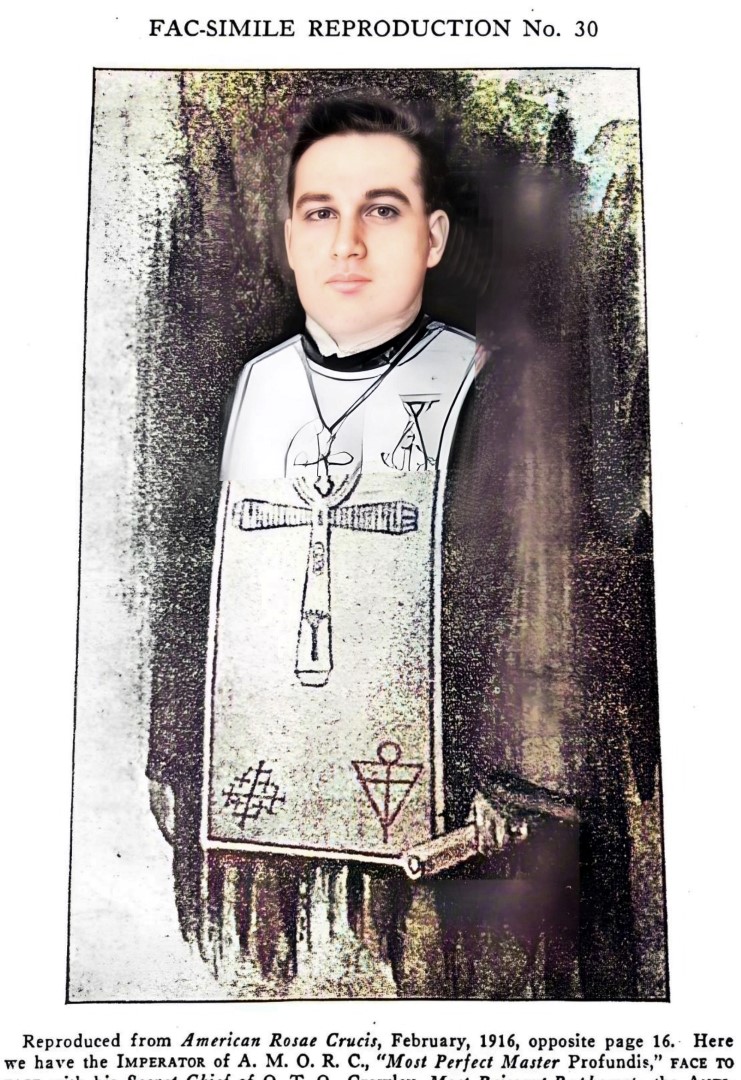
[Colored with AI] |
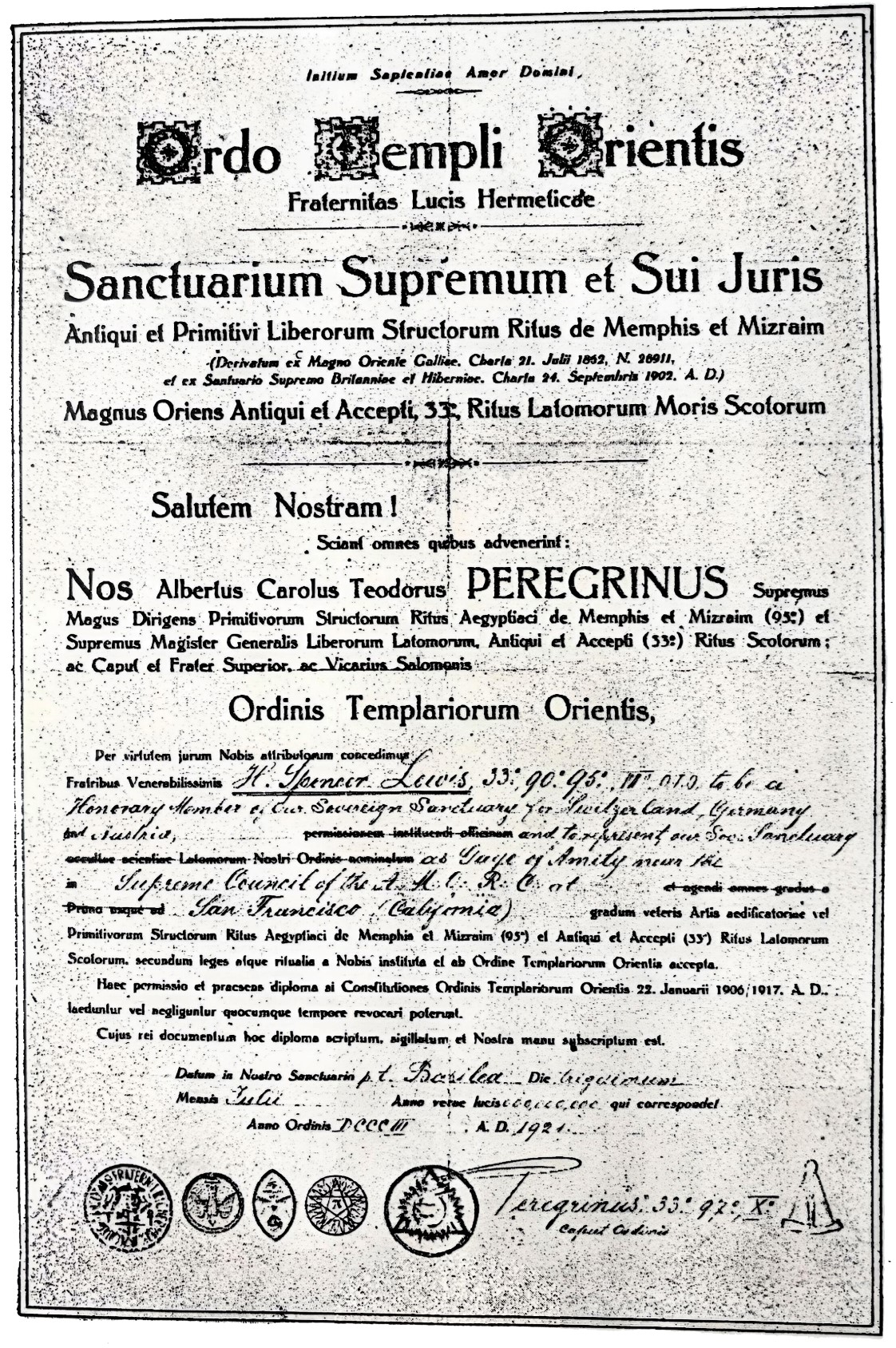
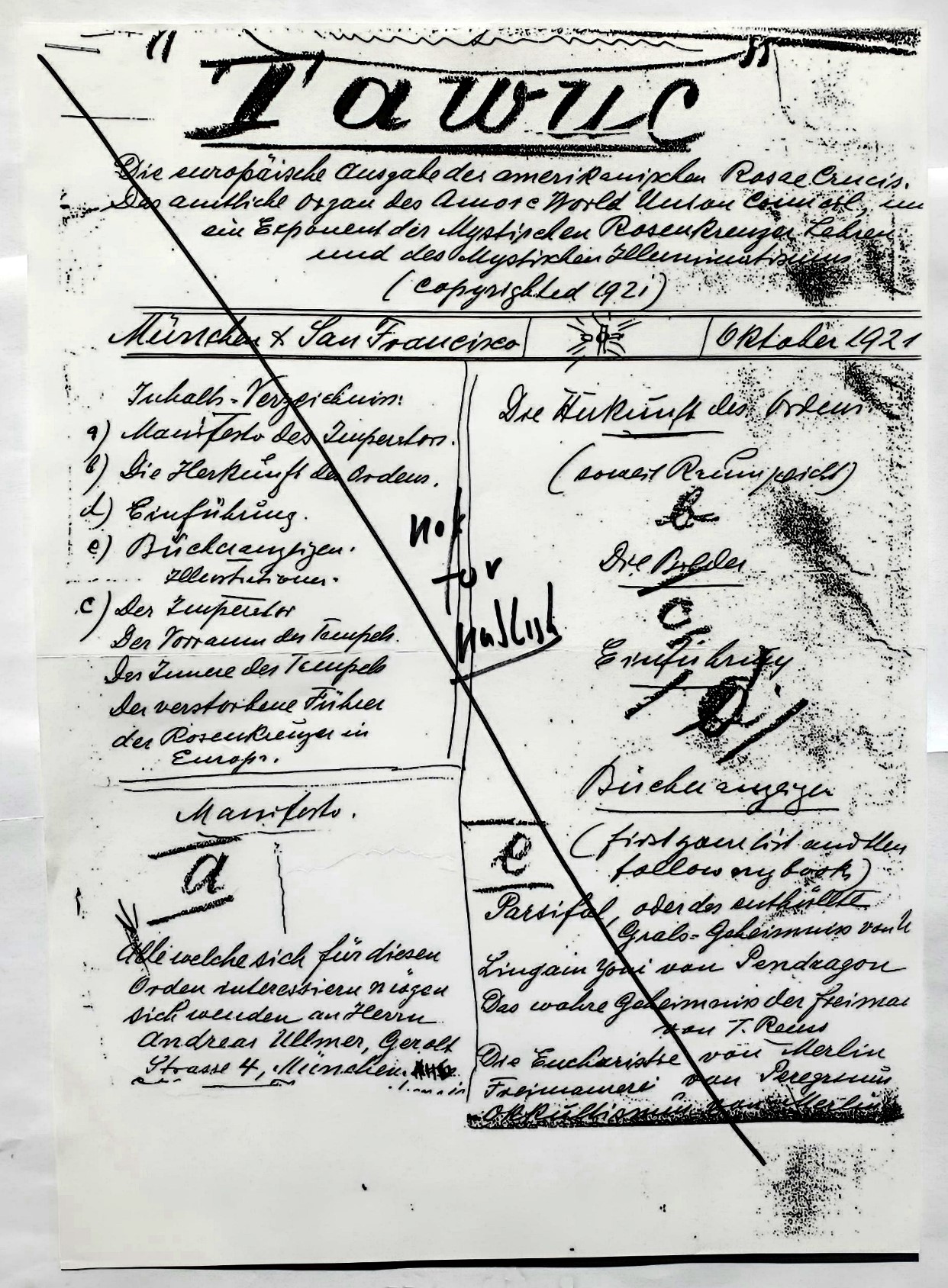
Documents issued by Theodor Reuss.
|
|

Preface
|
The information in this chapter derives partly from a correspondence
between myself, the A.M.O.R.C., and Robert Vanloo. An earlier version
of Mr. Vanloo's article on the controversy around the 1915 document
will be found in my book "Noch Mehr Materialien zum O.T.O.", while an
updated version is online.
Because the question of the A.M.O.R.C.'s Rosicrucian authenticity is irrelevant as far as the O.T.O. phenomenon goes, the associated arguments have been excluded here. [1] One of the pivotal points in a manifesto published by Robert Vanloo in February 1996 under the title of 'American Pronunziamento Number One', is whether the A.M.O.R.C. (Antiquus Mysticus Ordo Rosae Crucis) is a species of O.T.O. offshoot. [2] The relevant document that Vanloo unearthed at the New York Public Library only existed as a microfilm copy; it recorded a concordat between the A.M.O.R.C. and the O.T.O. in the year 1915, and is notable for having the term O.T.O. positioned in a frame in the actual body of the text. In reply to my query about this, on February 22nd 1999 the A.M.O.R.C. sent me a statement about the document, enclosing a photocopy of their version of the concordat preserved in their archives. This document's frame is quite empty of any reference to the O.T.O. It was also notable that neither version of the concordat gave an exact date (apart from February 1915), nor did they include the signature of H. Spencer Lewis, A.M.O.R.C.'s founder. The New York microfilmed version however does contain a marginal annotation in Lewis's handwriting, with the date February 8th written close by. The next image on this particular reel of microfilm is a handwritten letter from Lewis to a museum. 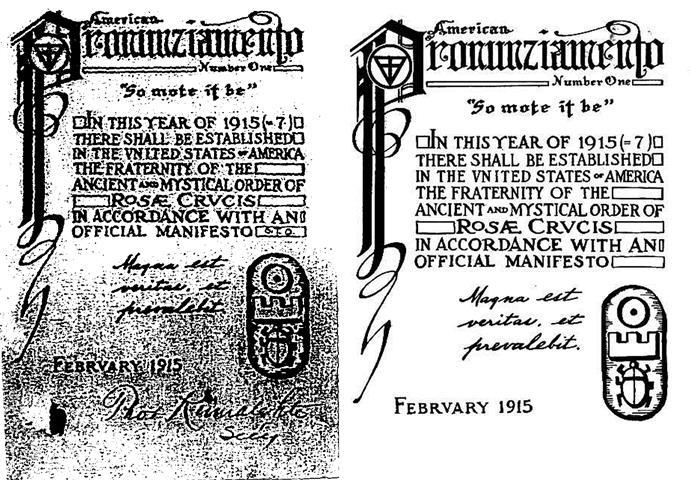
This naturally raised the question of which O.T.O. branch Lewis might have been in touch with at this period — Theodor Reuss's or Aleister Crowley's. For the moment this could not be answered, although A.M.O.R.C. asserted that the microfilmed version with O.T.O. written in the margin was a forgery. In the course of my own researches I had come across documentation which referred to a projected collaboration in founding an Order by Theodor Reuss and Harvey Spencer Lewis in late 1921. A.M.O.R.C. eventually made a detailed account in their letter of February 22nd 1999. Firstly they categorically denied a claim made by Gary Stewart, a former leader of theirs, that Lewis and Reuss had already met in 1909, when Lewis was travelling from France to England. [3] They adduced as evidence that neither the passenger-manifest nor crew-list of the ship Lewis was on, the 'Amerika', showed anybody called Theodor Reuss, let alone a ship's steward named A. Reuss. But it should be noted that Reuss often called himself Albert Reuss according his complete mundane name Karl Albert Theodor Reuss. HistoryHarvey Spencer LewisBy 1920 there is no doubt Lewis had heard of Reuss, and the latter's Masonic Congress held at Zürich during the summer of that year. Via Reuss's protégé McBlain Thomson ("33°, 96°, IX°, Sov. Grand Master General and Grand President General" of Salt Lake City) [4] Lewis wrote to Reuss on December 28th 1920; he had to wait until June 19th 1921 for a reply, since in the interim Reuss had fallen out with Thomson.
However, for Lewis's benefit, Reuss was now calling the O.T.O. the 'outer façade' of Rosicrucianism — which naturally intrigued Lewis, who was always on the look-out for genuine guaranteed Rosicrucians. In July 1921, thanks to Reuss, Spencer Lewis became an "Honorary Member [...] for Switzerland, Germany and Austria" with the degrees of 33°, 90°, 95°, and VII° — even though Lewis lived in the USA. Evidently, as there were already disagreements between Reuss and Crowley (who was the X° for Great Britain and Ireland), as well as Reuss and Jones (X° for the US since May 10th 1921), Lewis had no communication with the Crowleyan O.T.O. In September of that year Reuss and Lewis decided to give Rosicrucianism a new framework, in the form of something called 'The A.M.O.R.C. World Union Council', or TAWUC for short. Allied to this Reuss manufactured a dummy edition of an eponymous magazine, due to appear in October 1921; it publicised Reuss's own works on its book-review pages. [6] The name the magazine gave as TAWUC's contact is interesting: the IX° Andreas Ullmer, [7] which confirms the impression that the whole scheme had much more to do with Reuss than Lewis. Lewis certainly didn't agree with Reuss's book-reviews, where the latter had proclaimed that his sole intention was "to propagate the Saint [sic] gnostic Religion." Lewis's interest in the project rapidly dwindled, especially after August 9th 1921, when Reuss sent him a demand for more money towards the projected TAWUC magazine. Lewis was irritated at Crowley's promoting himself as the O.T.O.'s representative in the USA, and had previously denounced him as a fraudster in 1916. [8] Reuss now made great play of having ceased any contact with Crowley's magical son, Charles S. Jones / "Achad", and announcing that he had withdrawn Jones's authority to act in the O.T.O.'s name. The same went for Crowley, or so Reuss wrote in a letter to Lewis on October 25th 1921, in which he also bemoaned Lewis's lack of enthusiasm. Reuss, who had been active in the travel industry since 1909, and sat on the Munich Organising Committee of the Oberammergau Passion Plays, now felt able to announce a two-day Rosicrucian Convention on the same dates as the Passion Plays. [9] Lewis, again sensing that Reuss was mostly after money, gave his first reaction a month later by stating that he was no longer interested in collaborating with Reuss. Just as he had with Rudolf Steiner and Franz Hartmann sixteen years before, Reuss fired off several urgent letters to Lewis, who promptly informed him on May 22nd 1922 that no A.M.O.R.C. members would be travelling to the Passion Plays. No further correspondence took place. C.S. Jones reported to Reuss on 31 August 1922 that Lewis and his wife secretly had been present at an O.T.O. meeting but that Lewis spoke very negatively about Crowley. Because Spencer Lewis (1883–1939) (leader of the A.M.O.R.C.) threatened Theodor Reuss (1855–1923) (founder of the O.T.O., in 1906) that A.M.O.R.C.would stop paying its O.T.O. subscriptions if Aleister Crowley remained a member of the O.T.O.; and because Crowley was upset at Reuss granting (on 13th June, 1921 Charles S. Jonesthe highest U.S. degree (the X°), in the autumn of 1921, Reuss distanced himself from Crowley, turning towards the A.M.O.R.C. and to Arnoldo Krumm-Heller’s Rosicrucian organisation, the Fraternitas Rosicruciana Antiqua (F.R.A.). After receiving his honorary diploma from Reuss, Lewis sent a telegram, dated 24th August, 1921, asking “What connection has Crowley with your organization.” To which Reuss replied “Dissolved.” In October, 1921, Reuss informed Lewis that he had cut the O.T.O. connection between Reuss and Crowley, adding that whatever Crowley might happen to do about it in the U.S.A. was now his own business and no longer any concern of the O.T.O.. On 9th November, 1921, Reuss wrote to Crowley: “the ‘O.T.O.’ is not in any way an annex or even in any way connected with the ‘AA’ [Crowley’s Argenteum Astrum, A.·. A.·.] and [...] the Teachings of these Two independent Bodies must rigorously be kept separate and distinct.” To which Crowley replied (on 23rd November, 1921) that it was his “will to be O.H.O. and Frater Superior of the Order and avail myself of your abdication — to proclaim myself as such.” Several days later, on 27th November, 1921, Crowley noted in his diary: “I have proclaimed myself O.H.O. [Outer Head of the Order] Frater Superior of the Order of Oriental Templars.” From then on, in Rosicrucian circles it was considered that “During the last two years of [Reuss’s] life he was not active in teaching the Crowley doctrines and practices and regained the respect previously accorded to him in occult and fraternal circles.” Ordo Templi Orientis - Mysteria Mystica Maxima - The 'Caliphate' - The Swiss O.T.O.: Theodor Reuss, Spencer Lewis, Aleister Crowley, Phyllis Seckler, Karl Germer, Jane Wolfe, Jean Brayton, Grady Louis McMurtry, Helen Parsons-Smith, Oscar Schlag, Marcelo Ramos Motta, Euclydes Lacerda de Almeida, Gerald Yorke, Israel Regardie, John Symonds, Kenneth Grant, Martin Starr, William Breeze, William Heidrick, James Wasserman, James Grαeb, Hermann Joseph Metzger, Annemarie Aeschbach, Anita Borgert, Olaf Raederer, Ernst Graf, Adalbert Schmid, Martha Kuentzel Reuss's friend Arnoldo Krumm-Heller had his own version of events to relate in his magazine "Rosa-Crux" (Berlin November 27th 1935, Vol. IX Nº 8, p. 64): "I was a little anxious about Dr. Spencer having selected those documents, since a Dr. Krumm-Heller and a Huiracocha figured in them; this was from one of the magazines I had issued in 1921 with Master Reuss. Those brothers who had that booklet [WHITE BOOK D] would have seen me in the photograph reproduced as plate ten, [10] at my meeting with Dr. Hartmann, of whom 'A.M.O.R.C.' maintained — against all reason — that he was a Rosicrucian. I was also present at the signing of the document at Paris in 1908. Which means, my dear brothers, that although I took no part in this ceremony where I appear alongside Spencer Lewis, this was one of our offshoots. Nowadays in all Spencer Lewis's publications — which I cannot deny have certain merits — one can see, to speak bluntly, that a good deal is owed to my master, Supreme Magus Peregrinus. His faith in A.M.O.R.C. sustained him in his last years, when I knew him in Germany; A.M.O.R.C. had led him to believe that he would receive five dollars a month from their activities in Spain, since he was starving to death. And no, I am not speaking figuratively: sadly Reuss really was dying of hunger, and the disciple who owed him everything never even bothered to send him a single dollar. Reuss himself told me this on one occasion, weeping bitterly." Herr Heinrich TraenkerAfter Reuss's death in 1923, Lewis (as Crowley's rival) publicly sought an alliance with a rescension of the O.T.O. which differed from the Great Beast's group. Since Hans Rudolf Hilfiker was on the point of joining forces with Reuben Swinburne Clymer, and as Clymer led an organisation that competed directly with A.M.O.R.C., Lewis made no use of the Swiss O.T.O. which had been named in his Warrant, but turned to Heinrich Traenker in Germany. Lewis obviously had nothing against allying himself with Tränker, who had signed himself as "National Grand Master of the O\T.·.O\" in a letter to him. In August 1930 the two men planned a 'Pansophia International Rosicrucian Council,' which under the twin banners of O.T.O. and A.M.O.R.C. would send out a 'Second Fama' ("come all ye hither — enter in! [...] 33° 90° 96° X°"), though this seems merely to have been a stratagem on Lewis's part to lend A.M.O.R.C. some Rosicrucian legitimacy. [11] Lewis wrote to a certain M. Carl on February 16th 1932, and mentioned that Reuss had been the "secret chief of the O.T.O. and the Oriental Pansophia." Lewis's enemy Krumm-Heller likewise used the title "Societas Pansophia" on his letter-headings in the 1920's — as opposed to Tränker who signed his letters and so on as "Summum Supremum Sanctuarium Fraternitas Rosae Crucis Antiqua". Pansophy, though, was Tränker's main name for his own collection of Orders.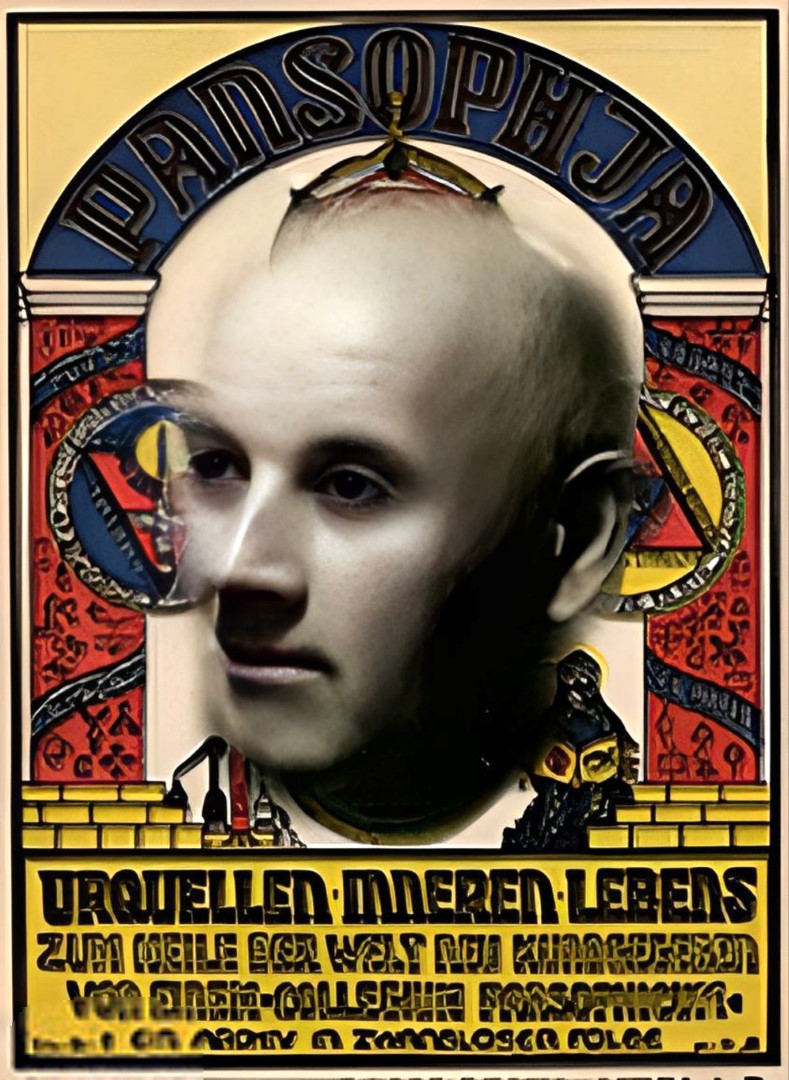
It is not entirely clear why either Rudolf Steiner or Spencer Lewis had dealings with dubious types like Reuss, Tränker, and Crowley. Were titles like "Memphis-Misraim" and "Rosicrucian" so terribly seductive? Lewis asserted that "The term Pansophia is referred to as a division of the Rosicrucian studies and work and not as a separate school or a separate organisation." [12] In 1931 Tränker's main base of operations was initially called 'Pansophische Rosenkreuzer-Grossloge zum Hütenden Greif' ('Pansophical-Rosicrucian Grand Lodge of the Guardian Griffin'), and after August 19th that year 'Pansophische Rosenkreuzerloge zur Weltenesche' ('Pansophical Rosicrucian Lodge of the World-Ash'). It did not last long. By April 1933 Lewis was openly mocking Tränker, [13] and in 1934 established the FUDOSI (Federation Universalis Dirigens Ordines Socientesque Initiatiques), in which — amongst others — the Église Gnostique Universelle had a part to play. When FUDOSI was convened in Brussels, Lewis condescended to permit his Rosicrucian legitimacy to be accredited by Jean Mallinger's sparring-partner Marc Laval. It was this same Laval who had confessed to practising 'Karezza' (otherwise "coitus interruptus") in the Belgian journal "Light Liberty, Naturism — Nudism, Sexology — Social Action". [14] Lewis even described Paschal Beverley Randoph (one of the founders of the Hermetic Brotherhood of Light/Luxor) as one of the "foremost men of the Order". [15] FUDOSI had been convened with the sole aim of buttressing Lewis's claims to Rosicrucian legitimacy, and was promptly disbanded once it had served its purpose; but it brought Reuben Swinburne Clymer back into the picture. As a direct competitor to Lewis, Clymer was trying to unite all friendly Rosicrucian organisations under one roof — his own. [16] Having lost a lawsuit against A.M.O.R.C. in 1935, Clymer published his ponderous two-volume opus "The Rosicrucian Fraternity in America", which contained accusations against A.M.O.R.C., and also established that Lewis had reproduced forged documents in his books — for instance Reuss's 1917 O.T.O. invitation to a meeting of the "Ladies of the Rosy+Cross", or the O.T.O. Statutes of the same year. Clymer's attacks on Crowley, meant to damn A.M.O.R.C. by association (Clymer seems to have thought that A.M.O.R.C. was a branch of Crowley's O.T.O.) roused the Great Beast — who at that time was in urgent need of a new source of money — to try and re-establish contact with Imperator Lewis. Spencer Lewis and Aleister CrowleyThe two men met in New York in the spring of 1918. [17]After the meetings between June 22nd and July 1918 Crowley drafted a long paper, in which he offered Lewis the choice of membership in either the O.T.O., the A.·. A.·., or the Illuminati Order — though Lewis never recieved this document. 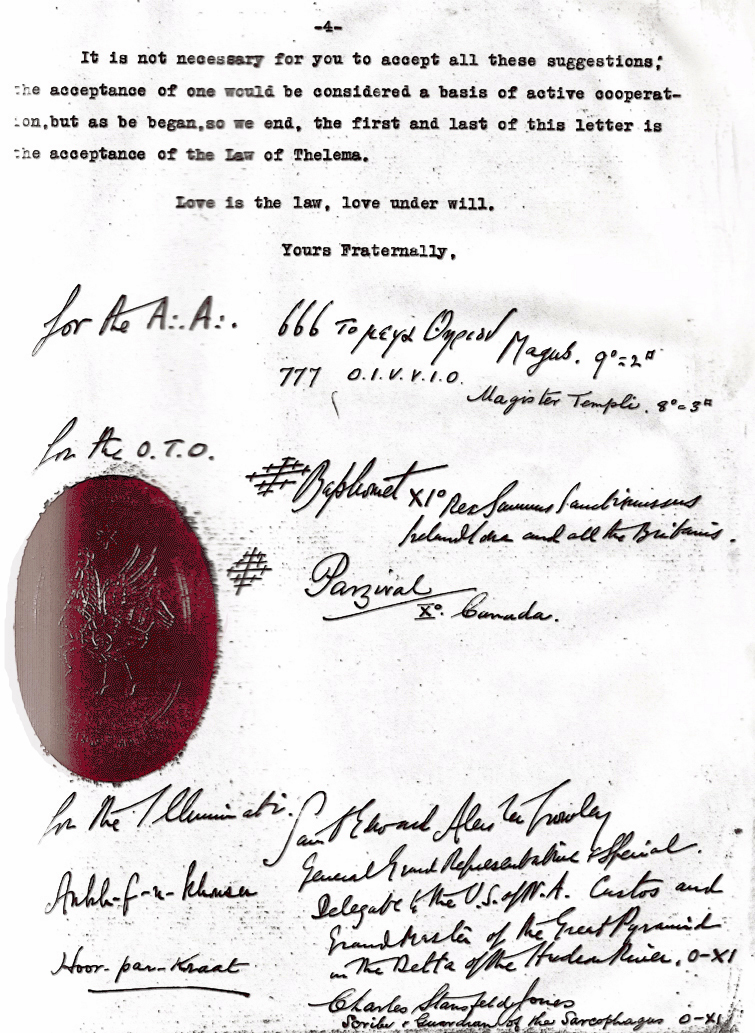
In 1935 Crowley went bankrupt. To settle the debts he owed his lawyers Isador Caplan and Isidore Kerman, his draft offer to Lewis was handed over to them amongst other things. In 1996 the Caplan-Kerman estate was auctioned at Sotheby's, and this document turned up among the collection. Crowley acted thus to pay off his outstanding debts, because otherwise he could easily have ended up in prison as an undischarged bankrupt. In 1935 the financial possibilities that A.M.O.R.C. offered were clearly in his sights, and his letters to them were initially couched in very courteous terms. In his first letter to Lewis on August 19th 1935, Crowley offered his aid in the dispute with Reuben Swinburne Clymer, who had defended Reuss in his books, but denounced Crowley as a black magician. Clymer also believed he had proved that the A.M.O.R.C. stemmed from Crowley's O.T.O. — so the Great Beast (a.k.a. Crowley) was only too pleased to enter the fray. Crowley laid siege to Lewis on several fronts, in direct correspondence, through Raymund Andrea (Lewis's representative in London), and via Max Schneider, Tränker's ex-friend and co-founder of the 2nd Agapé Lodge in California, who was similarly finagled into contacting the A.M.O.R.C.'s headquarters in San José. On September 5th 1935 Andrea got a letter from Crowley, in which he announced that since he, Crowley, was OHO of his O.T.O., he was also Chief of all Rosicrucians, and hence the fate of A.M.O.R.C. rested in his hands. Andrea contacted Lewis and informed him of Crowley's money-troubles and his dubious reputation — on which Clymer's books seemed to set the final seal — but Lewis was quick to allay Andrea's fears. At this stage Max Schneider turned up at the Los Angeles offices of A.M.O.R.C.'s lawyer, Arthur B. Walker, identifying himself as Crowley's representative. Schneider proposed an alliance in the legal battle against Clymer, and expressed his hopes that A.M.O.R.C. would provide financial support to this end. He argued that cleaning up Crowley's unsavoury reputation would automatically yield an improvement for A.M.O.R.C.'s image. A second meeting between Schneider and Walker took place on September 18th 1935; Schneider wanted in vain admittance to the A.M.O.R.C. headquarters in San José, so that he could discuss the ways and means by which Crowley might be helped. The upshot of all this lobbying was a dozen or so letters between Lewis, Andrea, Walker and Crowley, up to January 1936. Lewis made it clear that Reuss had expelled Crowley from the O.T.O. on October 25th 1921, and Crowley learnt that Lewis wasn't going to give him any money. Naturally Lewis refused to cede the A.M.O.R.C. to Crowley (who was "prepared to take over the whole of the A.M.O.R.C."). [18] W.T. Smith stated of Lewis's 1921 Reussian charter that Lewis was "not a full member [and that the Reuss charter] is not a warrant, it is not a charter." [19] Despite this, Crowley continued to maintain that A.M.O.R.C. derived its authority from precisely this charter, and thus the entire A.M.O.R.C. estate belonged to him alone. [20] Because Lewis had made use of the O.T.O.'s lamen in his publications [21] Crowley falsely claimed that it was his own invention. But Lewis stayed calm in the face of Crowley's legal threats. Crowley is alleged to have tried to recruit Lewis's enemy Arnoldo Krumm-Heller: "Unfortunately my people in California, although most devoted and intelligent, are not precisely men of the world and do not understand how to handle big affairs. It is imperitive [sic] that I should go over there and put the screws on Spencer Louis [sic]. That is largely a question of finance. We should have to put at least £500 aside for the purpose of the journey. As soon as I got to California there would be no difficulties, because over there nobody bothers about chaperty [?property]." [22] In 1937 Crowley was as much preoccupied by A.M.O.R.C. as he was by sex-magic; here are some extracts from his diaries: 5. Sept. 37: [Crowley asked the I-Ching] Give Omen for Amorc affair. XVIII Ku Thwan: go ahead, but plan most carefully, & check every step. Line 1: Clear Reuss. 2. Clear O.T.O. 3. Clear Reuss, admitting some error. 4. Excuse Reuss. 5. Find fit instrument. 6. Appear as sole O.H.O. 6. Sept. 37: XVIII Ku. Curious! Obvious meaning — attend to Amorc. Got Amorc file Whiteley. 14. Sept. 37: Lewis in full retreat: drops the A of Amorc from his advertisements! Quelle crapule! 28. Sept. 37: preparing A.M.O.R.C. plan. 29. Sept. 37: Wrote Center[?] re Amorc. 1. Oct.37: [sex-magic with Evelyn] to control A.M.O.R.C.. 2. Oct.37: [sex-magic with Phyllis] to control Amorc. (Something tells me this may have been operative — against my judgement). 7. Oct.37: Bentley's: A.M.O.R.C. 8. Oct.37: Phyllis here. [sex-magic] to capture Amorc. 9. Oct.37: Wrote Larwal[?] re the Fudosi. 18. Oct.37: D. Herald wants Amorc story. 20. Oct.37: Lunch with Tebbs. Chess. Discussing Amorc story. 23. Nov.37: Long talk with Fraser: showed him A.M.O.R.C. stuff." Spencer Lewis died on August 2nd 1939; his son Ralph led the organisation subsequently. The rituals and monographs written by Spencer Lewis have not been used by A.M.O.R.C. since that time. FOOTNOTES
This is an outline from Der O.T.O. Phänomen Remix" [out of print. Enlarged version see Der O.T.O. Phänomen RELOAD]. Overview on A.M.O.R.C. and the O.T.O. Translated by Mark Parry-Maddocks. 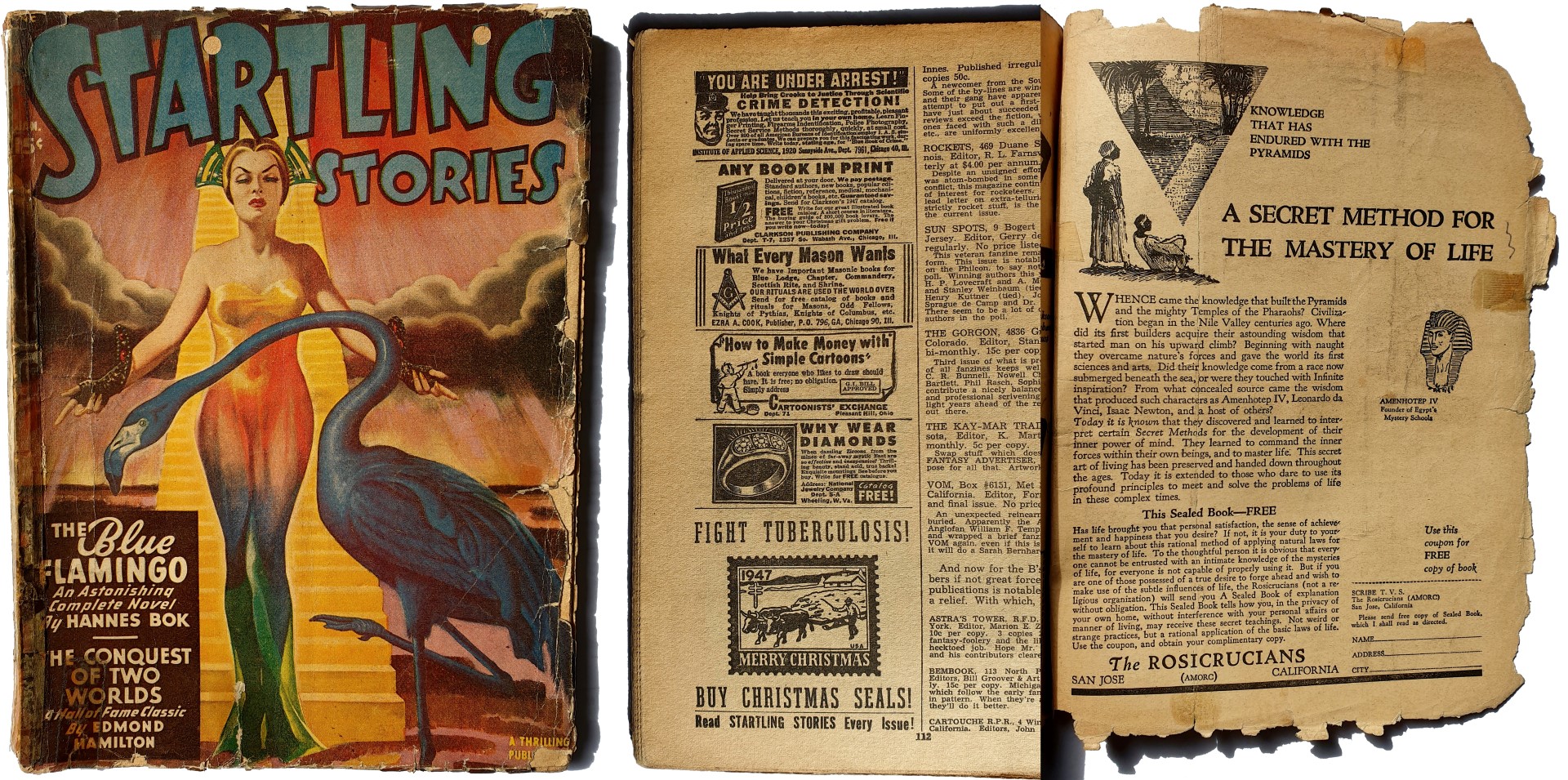
'Startling Stories", January 1948. More about Heinrich Traenker:

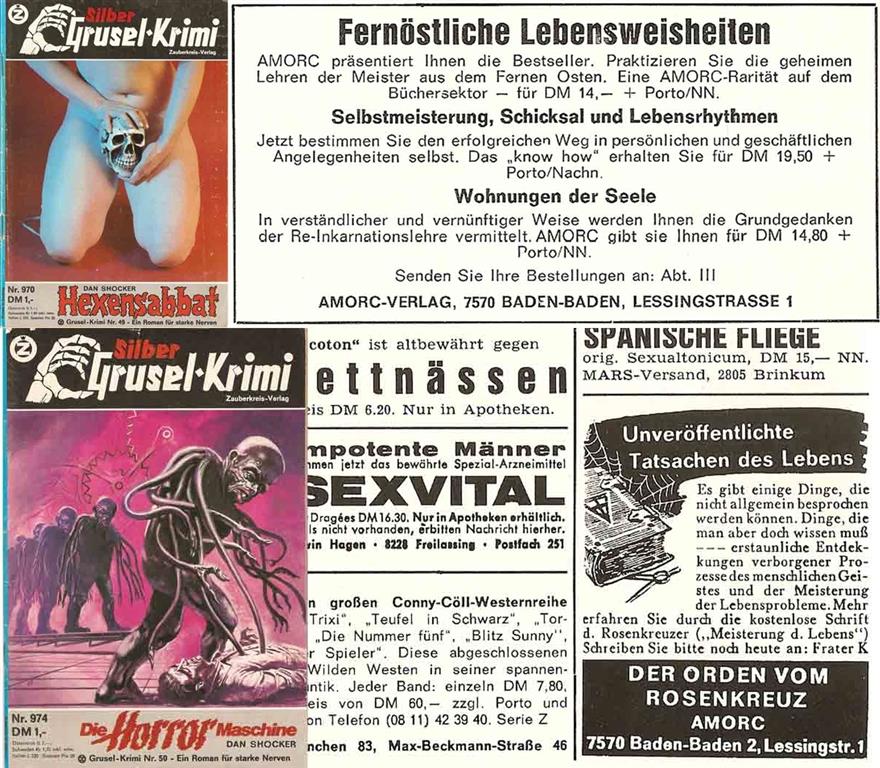
O.T.O. Phenomenon content page | main page | mail Peter-R. Koenig What's New on the O.T.O. Phenomenon site? |
|
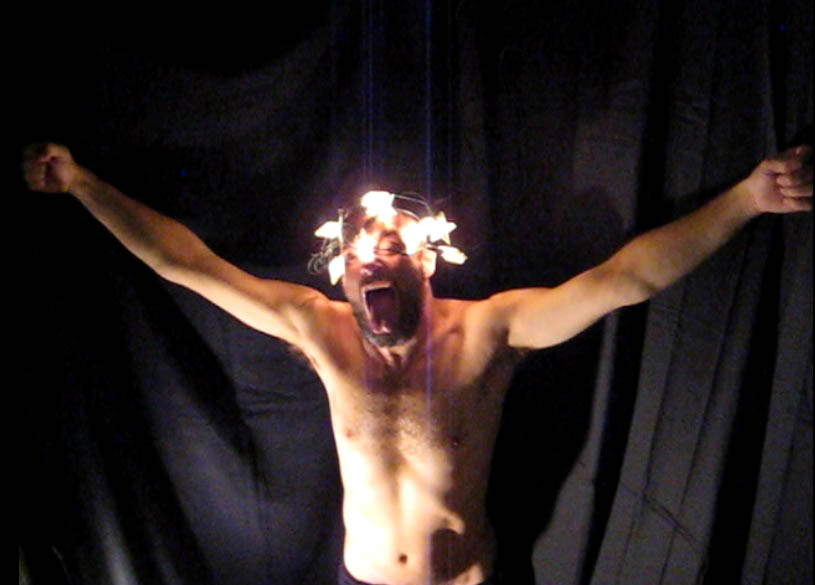
|
